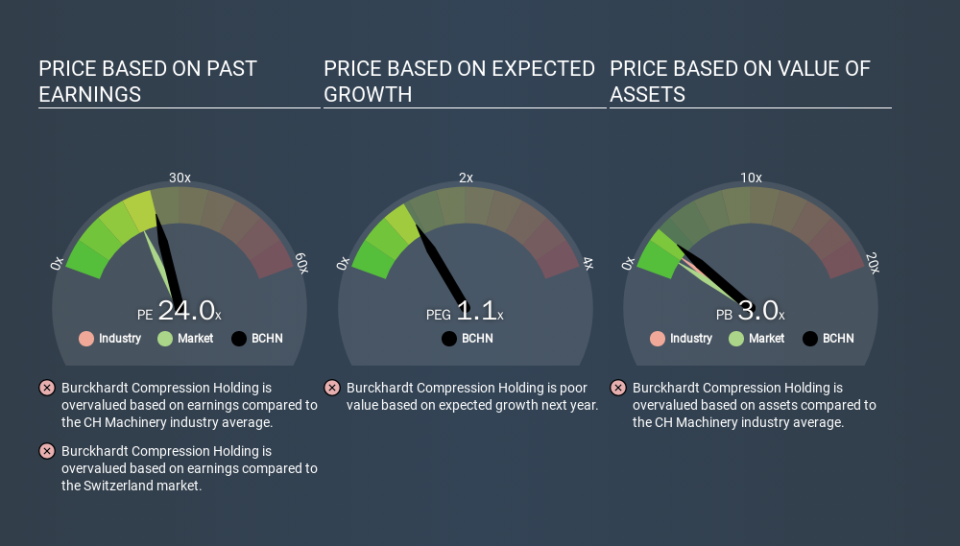Should We Worry About Burckhardt Compression Holding AG's (VTX:BCHN) P/E Ratio?

This article is written for those who want to get better at using price to earnings ratios (P/E ratios). We'll look at Burckhardt Compression Holding AG's (VTX:BCHN) P/E ratio and reflect on what it tells us about the company's share price. Burckhardt Compression Holding has a price to earnings ratio of 24.00, based on the last twelve months. That means that at current prices, buyers pay CHF24.00 for every CHF1 in trailing yearly profits.
See our latest analysis for Burckhardt Compression Holding
How Do I Calculate A Price To Earnings Ratio?
The formula for price to earnings is:
Price to Earnings Ratio = Share Price ÷ Earnings per Share (EPS)
Or for Burckhardt Compression Holding:
P/E of 24.00 = CHF246.00 ÷ CHF10.25 (Based on the trailing twelve months to September 2019.)
Is A High P/E Ratio Good?
A higher P/E ratio means that investors are paying a higher price for each CHF1 of company earnings. That is not a good or a bad thing per se, but a high P/E does imply buyers are optimistic about the future.
Does Burckhardt Compression Holding Have A Relatively High Or Low P/E For Its Industry?
One good way to get a quick read on what market participants expect of a company is to look at its P/E ratio. The image below shows that Burckhardt Compression Holding has a P/E ratio that is roughly in line with the machinery industry average (23.6).
Its P/E ratio suggests that Burckhardt Compression Holding shareholders think that in the future it will perform about the same as other companies in its industry classification. The company could surprise by performing better than average, in the future. Checking factors such as director buying and selling. could help you form your own view on if that will happen.
How Growth Rates Impact P/E Ratios
Companies that shrink earnings per share quickly will rapidly decrease the 'E' in the equation. Therefore, even if you pay a low multiple of earnings now, that multiple will become higher in the future. So while a stock may look cheap based on past earnings, it could be expensive based on future earnings.
In the last year, Burckhardt Compression Holding grew EPS like Taylor Swift grew her fan base back in 2010; the 64% gain was both fast and well deserved. Regrettably, the longer term performance is poor, with EPS down 9.1% per year over 5 years.
Don't Forget: The P/E Does Not Account For Debt or Bank Deposits
It's important to note that the P/E ratio considers the market capitalization, not the enterprise value. In other words, it does not consider any debt or cash that the company may have on the balance sheet. Theoretically, a business can improve its earnings (and produce a lower P/E in the future) by investing in growth. That means taking on debt (or spending its cash).
Spending on growth might be good or bad a few years later, but the point is that the P/E ratio does not account for the option (or lack thereof).
How Does Burckhardt Compression Holding's Debt Impact Its P/E Ratio?
Net debt totals just 8.6% of Burckhardt Compression Holding's market cap. So it doesn't have as many options as it would with net cash, but its debt would not have much of an impact on its P/E ratio.
The Bottom Line On Burckhardt Compression Holding's P/E Ratio
Burckhardt Compression Holding's P/E is 24.0 which is above average (19.6) in its market. While the company does use modest debt, its recent earnings growth is superb. So on this analysis a high P/E ratio seems reasonable.
When the market is wrong about a stock, it gives savvy investors an opportunity. If the reality for a company is better than it expects, you can make money by buying and holding for the long term. So this free visual report on analyst forecasts could hold the key to an excellent investment decision.
But note: Burckhardt Compression Holding may not be the best stock to buy. So take a peek at this free list of interesting companies with strong recent earnings growth (and a P/E ratio below 20).
If you spot an error that warrants correction, please contact the editor at editorial-team@simplywallst.com. This article by Simply Wall St is general in nature. It does not constitute a recommendation to buy or sell any stock, and does not take account of your objectives, or your financial situation. Simply Wall St has no position in the stocks mentioned.
We aim to bring you long-term focused research analysis driven by fundamental data. Note that our analysis may not factor in the latest price-sensitive company announcements or qualitative material. Thank you for reading.

